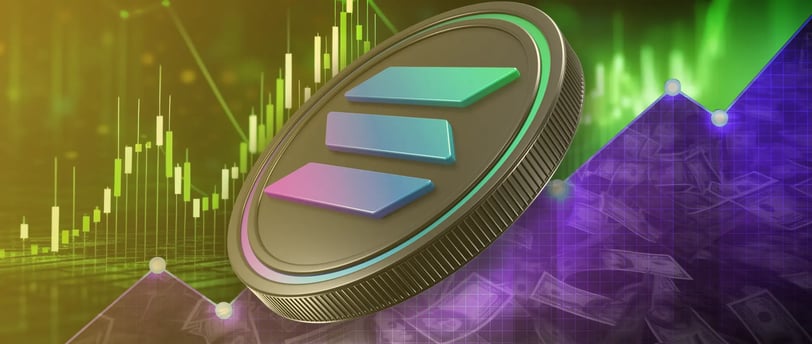Solana (SOL): A Comprehensive Analysis of the High-Performance Blockchain
CRYPTO MARKET
2/10/20254 min read


Solana (SOL) is one of the leading cryptocurrencies in the market, standing out for its speed, scalability, and low transaction fees. Since its launch, it has attracted developers, investors, and blockchain technology enthusiasts. In this article, we will explore the key aspects of this network, including its founders, purpose, market segmentation, supply, history, ecosystem, and potential for appreciation.
Disclaimer: This article is for informational purposes only and does not constitute investment advice. Before making any financial decisions, consult a specialized professional.
Founders and Early Development
Solana was created by Anatoly Yakovenko in 2017. Yakovenko, a former Qualcomm engineer, had extensive experience in distributed systems and computer networks. He conceived an innovative mechanism called Proof of History (PoH), which would enable greater scalability in blockchain without compromising decentralization.
Alongside Yakovenko, Greg Fitzgerald and Eric Williams also contributed significantly to the development of Solana. The team founded Solana Labs, headquartered in San Francisco, California, and later established the Solana Foundation, a nonprofit organization overseeing the network ecosystem.
Purpose and Goals
Solana's primary objective is to offer a high-speed, scalable, and low-cost blockchain, allowing decentralized applications (dApps) to run efficiently. The network aims to solve the challenges of traditional blockchains, such as the slow speeds and high transaction fees experienced by Bitcoin and Ethereum.
Solana differentiates itself by combining Proof of History (PoH) with Proof of Stake (PoS), providing a more efficient consensus structure. PoH enables a verifiable sequence of events, reducing transaction processing time and increasing network throughput.
Market Segment
Solana directly competes with other smart contract platforms such as Ethereum, Binance Smart Chain (BSC), Avalanche, and Cardano. Its primary segments include:
Decentralized Finance (DeFi): Yield farming projects, staking, and decentralized lending protocols.
Non-Fungible Tokens (NFTs): Marketplaces for creating, buying, and selling NFTs.
Blockchain Gaming (GameFi): Play-to-Earn (P2E) games and the metaverse.
Decentralized Applications (dApps): Platforms utilizing smart contracts for financial services, social networks, and marketplaces.
Supply and Tokenomics
The SOL token is used for transaction fees, staking, and governance within the network. The total supply of SOL has a maximum cap of approximately 511 million tokens. Currently, a significant portion of the supply is in circulation, while the remainder is distributed among developers, validators, and the community.
Solana’s tokenomics is designed to incentivize validators and investors, with a gradual reduction in inflation over time.
Solana's History Over the Years
2017: Anatoly Yakovenko publishes the Proof of History whitepaper.
2018-2019: Initial development and network testing.
2020: Official launch of the mainnet beta and listing of the SOL token on exchanges.
2021: SOL experiences a significant price surge, reaching its all-time high of approximately $260, driven by the growth of the DeFi and NFT ecosystem.
2022: Network congestion issues and multiple outages raise concerns within the community.
2023: Significant improvements in network stability, renewed growth of projects built on Solana, and increased institutional adoption.
Solana Ecosystem
Solana has a diverse ecosystem spanning multiple areas. Here are some notable crypto assets from its key segments:
DEXs (Decentralized Exchanges): Raydium, Jupiter, Serum, and Orca.
NFT Marketplaces: Magic Eden and Solanart.
DeFi Protocols: Solend, Marinade Finance, and Tulip Protocol.
Games: Star Atlas, Yaku, and Aurory.
DePIN: Helium (HNT), Shadow Token.
Oracle: Pyth Network.
The network continues to expand its developer base and strategic partnerships, making it an increasingly viable option for new projects.
Solana, the "Ethereum Killer"?
Solana is often referred to as an "Ethereum Killer" due to its scalability, speed, and lower costs compared to Ethereum. While it has not "killed" Ethereum, it has certainly increased competition and offers a highly efficient alternative for developers and users in the blockchain space. Here are some reasons behind this nickname:
Speed and Scalability
Solana can process up to 65,000 transactions per second (TPS), whereas Ethereum processes an average of 15-30 TPS on the mainnet (before Ethereum 2.0).
Its high speed is enabled by its unique Proof of History (PoH) mechanism, which complements Proof of Stake (PoS) by creating a chronological timeline of transactions.
Low Transaction Costs
While Ethereum gas fees can range from a few dollars to hundreds during periods of high congestion, Solana's fees generally remain around fractions of a cent.
Modern Infrastructure
Solana was built from the ground up with a high-performance architecture, avoiding bottlenecks that older blockchains face.
Its approach balances scalability with decentralization, something Ethereum is still working to achieve.
Growing Applications
Solana is a robust ecosystem for decentralized applications (dApps) and decentralized finance (DeFi), with projects like Serum, Raydium, and Magic Eden directly competing with Ethereum-based platforms.
Lower Energy Consumption
Compared to Ethereum before its transition to PoS, Solana has always operated with an energy-efficient model, attracting developers concerned with sustainability.
Potential for Appreciation
Solana has strong growth potential based on the following factors:
Scalability and Efficiency: With fast and cheap transactions, the network attracts new developers and users.
Increasing Adoption: Companies and projects are migrating to Solana due to its advanced infrastructure.
Strategic Partnerships: Collaborations with major industry players can further drive adoption.
Technological Evolution: Continuous improvements to the network can eliminate technical issues and strengthen its market position.
Despite challenges such as security issues and past network outages, Solana demonstrates an ability to evolve and establish itself as one of the leading blockchains in the market.
